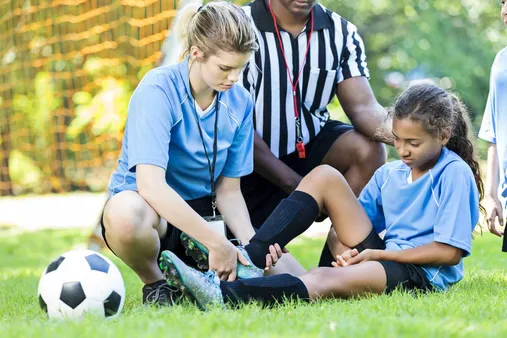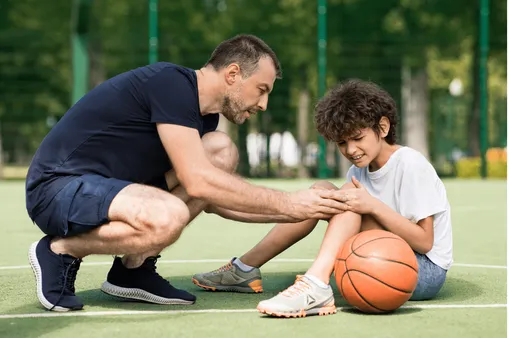Table of Contents
Gymnastics is a physically demanding sport that requires strength, flexibility, and coordination. While it can be a rewarding and enjoyable activity, it also carries a risk of injury. At Kizworld, we understand the importance of injury prevention in gymnastics. That's why we've compiled this comprehensive guide to The most common gymnastics injuries and how to prevent them. In this article, we'll discuss the causes of these injuries and provide practical tips to help gymnasts stay safe and injury-free.
The most common gymnastics injuries and how to prevent them
I. Understanding the Common Gymnastics Injuries
Causes of Gymnastic Injuries
- Lack of proper form and technique
- Insufficient warm-up and stretching
- Training too hard or too often
- Nutritional deficiencies
- Inadequate conditioning
Gymnastics is a physically demanding sport that requires strength, flexibility, and coordination. While gymnastics can be a rewarding and enjoyable activity, it also carries a risk of injury. In this section, we will discuss the most common gymnastics injuries, their causes, and how to prevent them.
Preventing Gymnastics Injuries
Type of Injury | Prevention |
|---|---|
Sprains | - Perform proper warm-up and stretching exercises before each gymnastics session. - Use appropriate technique and form when performing gymnastics skills. - Strengthen the muscles that support the joints. - Wear supportive and well-fitting shoes. |
Strains | - Gradually increase the intensity and duration of your gymnastics workouts. - Avoid overtraining. - Strengthen the muscles that support the joints. - Use proper technique and form when performing gymnastics skills. |
Fractures | - Use proper technique and form when performing gymnastics skills. - Strengthen the muscles that support the bones. - Wear protective gear, such as a helmet and wrist guards, when performing certain skills. |
The most common gymnastics injuries include sprains, strains, fractures, and dislocations. These injuries can occur during training or competition, and they can range from minor to severe. In this section, we will provide tips for treating and recovering from gymnastics injuries.
II. Effective Preventive Measures for Common Gymnastics Injuries
Effective Preventive Measures for Common Gymnastics Injuries
There are a number of effective preventive measures that can be taken to reduce the risk of common gymnastics injuries. These measures include:
- Proper warm-up and cool-down: Warming up the muscles before exercise and cooling them down afterwards helps to prevent injuries. Read more about the difference between warming up and cooling down in exercise.
- Use of proper technique: Learning and practicing the correct techniques for each skill is essential for preventing injuries. This article will help you learn the basics.
- Use of proper equipment: Using the correct equipment, such as mats and spotting belts, can help to prevent injuries. Here's what you need for home use.
- Gradual progression of skills: Gradually increasing the difficulty of skills as the gymnast progresses helps to prevent injuries.
- Adequate rest and recovery: Allowing the body to rest and recover adequately helps to prevent injuries. Learn more about the importance of rest and recovery in sports.
- Mental preparation: Being mentally prepared for the challenges of gymnastics can help to prevent injuries. Here's more on mental preparation in sports.
Additional Tips for Preventing Gymnastics Injuries
In addition to the preventive measures listed above, there are a number of other things that gymnasts can do to reduce their risk of injury. These include:
- Listening to their bodies: Gymnasts should pay attention to their bodies and stop if they are feeling pain.Read about the importance of listening to your body in sports.
- Communicating with their coaches: Gymnasts should communicate with their coaches about any concerns they have regarding their health or safety. Learn more about communication between athletes and coaches.
- Participating in regular strength and conditioning workouts: Strength and conditioning workouts can help to improve strength, flexibility, and balance, which can help to prevent injuries. Here're the benefits of strength and conditioning for athletes.
- Eating a healthy diet: Eating a healthy diet provides the body with the nutrients it needs to stay healthy and strong. Here's the importance of nutrition for athletes.
- Getting enough sleep: Getting enough sleep helps the body to recover from exercise and reduces the risk of injury. Read more on the importance of sleep for athletes.
Gymnastics Injury | Prevention |
|---|---|
Sprains | Use proper technique, wear supportive shoes, and warm up properly. |
Strains | Use proper technique, stretch regularly, and gradually increase the intensity of your workouts. |
Fractures | Use proper technique, wear protective gear, and avoid risky maneuvers. |
Dislocations | Use proper technique, wear supportive shoes, and warm up properly. |
By following these preventive measures, gymnasts can reduce their risk of injury and enjoy a long and rewarding career in the sport.
III. Gymnastics Injuries: Prevention in Practice
Gymnastics Injuries: Prevention in Practice
Gymnastics is a physically demanding sport that requires strength, flexibility, and coordination. Gymnastics injuries can range from minor to severe, and they can be caused by a variety of factors, including improper technique, inadequate conditioning, and unsafe training environments. The best way to prevent gymnastics injuries is to ensure that gymnasts have the proper training and equipment, and that they follow safe practices while training and competing.
- Proper training. Gymnasts should receive qualified instruction from a coach who is experienced in gymnastics and injury prevention.
- Adequate conditioning. Gymnasts should be in good physical condition before they begin training. This includes having strong muscles, good flexibility, and a healthy cardiovascular system.
- Safe training environments. Gymnastics equipment should be inspected regularly to ensure that it is safe for use. The training facility should also be well-maintained and free of hazards.
In addition to these general guidelines, there are a number of specific things that gymnasts can do to prevent injuries. These include:
- Warm up properly before each workout. Warming up helps to prepare the body for exercise and reduce the risk of injury.
- Use proper technique when performing skills. Incorrect technique can put unnecessary stress on the body and increase the risk of injury.
- Listen to your body. If you are feeling pain, stop exercising and see a doctor. Pushing through pain can lead to serious injury.
- Take breaks. It is important to take breaks during workouts and training sessions to allow the body to rest and recover.
By following these tips, gymnasts can help to reduce their risk of injury and stay safe while enjoying their sport.
Injury | Symptoms | Treatment |
Sprains | Pain, swelling, and bruising | Rest, ice, compression, and elevation |
Strains | Pain, swelling, and tenderness | Rest, ice, compression, and elevation |
Fractures | Intense pain, swelling, deformity, and bruising | Immobilization, surgery, and physical therapy |
Dislocations | Intense pain, deformity, and loss of function | Reduction, immobilization, and physical therapy |
If you are a gymnast, it is important to be aware of the risks of injury and to take steps to prevent them. By following the tips in this article, you can help to stay safe and enjoy your sport for many years to come.
For more information on gymnastics injuries, please visit the Kizworld website.
IV. Maintaining Gymnastics Safety and Injury Prevention
Maintaining Gymnastics Safety and Injury Prevention
Encouraging Proper Technique and Form
Proper technique and form are essential for preventing injuries in gymnastics. Gymnasts should be taught the correct way to perform each skill and movement, and they should practice these skills regularly to develop muscle memory.
Coaches and instructors should provide clear and concise instructions, and they should be patient and encouraging. They should also be willing to answer questions and provide feedback.
Read more about Improving Your Flexibility and Mobility With Gymnastics
- The key to preventing injuries in gymnastics is to focus on proper technique and form.
- Gymnasts should be taught the correct way to perform each skill and movement.
- Coaches and instructors should provide clear and concise instructions and be patient and encouraging.
Warming Up Before Exercise
Warming up before exercise is another important way to prevent injuries. Warming up helps to increase blood flow to the muscles and prepares them for activity. This can help to reduce the risk of muscle strains, sprains, and other injuries.
A warm-up should include light aerobic activity, such as jogging or jumping jacks, followed by dynamic stretches. Dynamic stretches are stretches that involve movement, such as leg swings or arm circles.
Read more about Mastering Basic Gymnastics Skills
Type of Warm-Up | Examples |
|---|---|
Light Aerobic Activity | Jogging, jumping jacks, skipping rope |
Dynamic Stretches | Leg swings, arm circles, torso twists |
Stretching and Exercise
Stretching exercises can help to improve flexibility and range of motion, which can also help to prevent injuries. Stretching exercises should be done both before and after exercise.
Examples of stretching exercises for gymnasts include:
- Hamstring stretch: Stand with one leg extended behind you and the other leg bent at the knee. Bend forward from the hips and reach for your toes.
- Quadriceps stretch: Stand with one leg in front of the other and bend your front knee so that your thigh is parallel to the ground. Reach forward and grab your ankle.
- Calf stretch: Stand on a step or curb with your heels hanging off the edge. Slowly lower your body until you feel a stretch in your calves.
Conditioning
Conditioning exercises can help to strengthen muscles and improve endurance, which can also help to prevent injuries.
Examples of conditioning exercises for gymnasts include:
- Core exercises: Planks, sit-ups, and crunches are all great exercises for strengthening the core muscles.
- Leg exercises: Squats, lunges, and leg presses are all good exercises for strengthening the leg muscles.
- Upper body exercises: Push-ups, pull-ups, and rows are all good exercises for strengthening the upper body muscles.